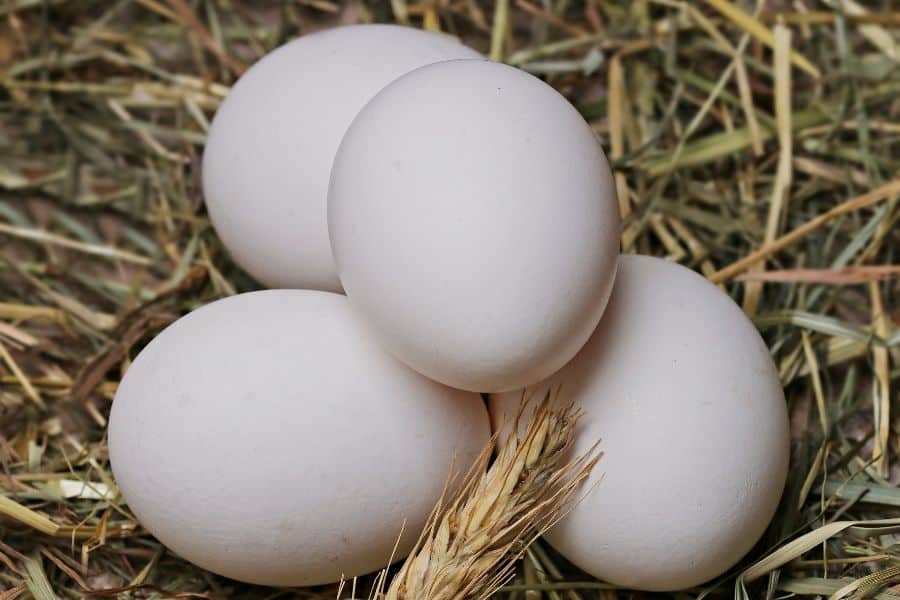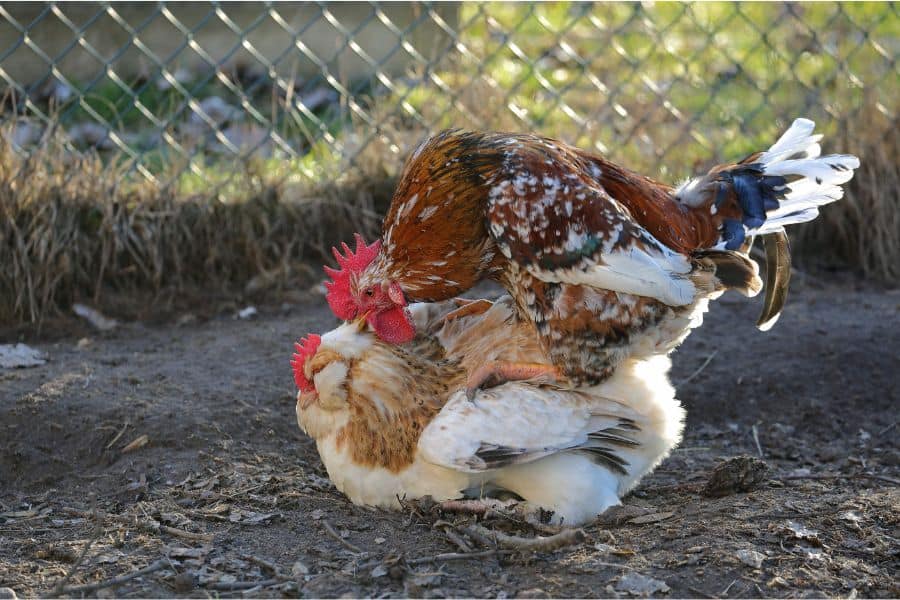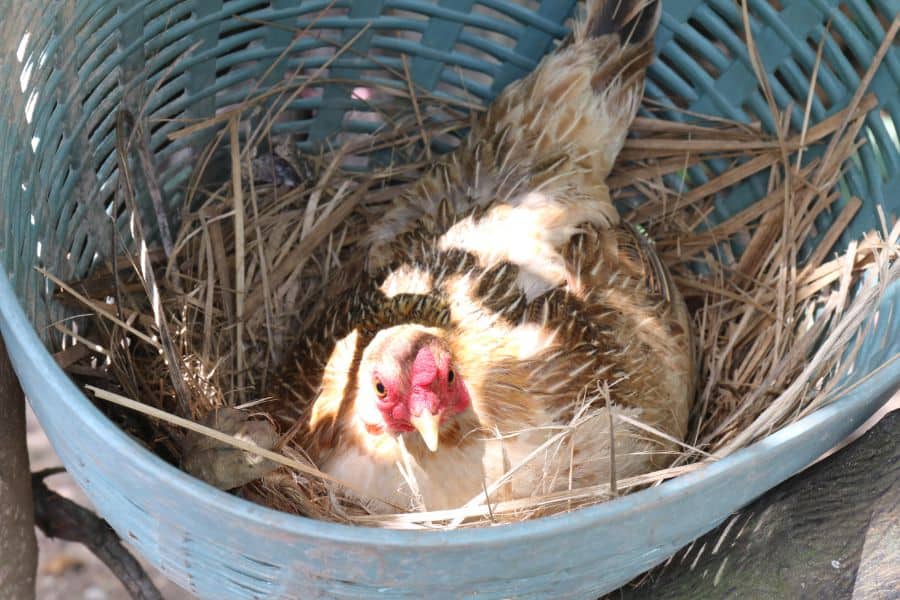Did you know hens can lay eggs without roosters?
It’s true! Hens don’t need male chickens to give you that flavourful eggs you enjoy. However, this only applies if you raise chickens for the sole purpose of egg production.
But if you wish to increase your chicken population, you need to understand egg fertilization in chickens.
You may be thinking, are there, not enough articles that cover this topic?
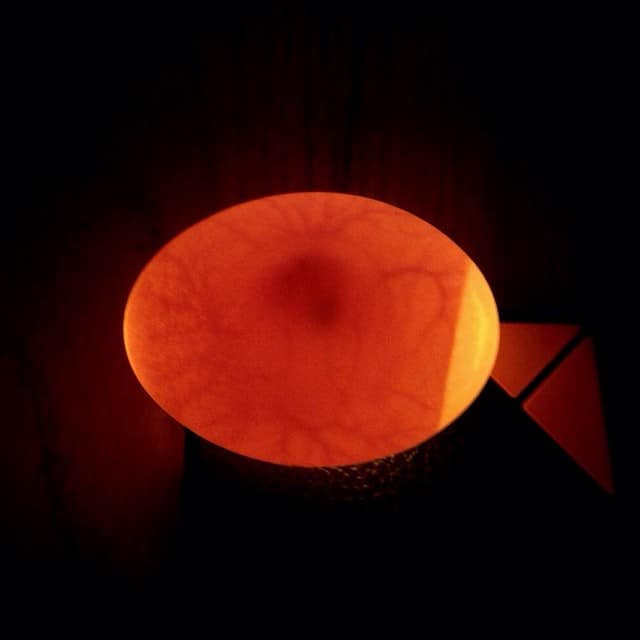
The short answer is yes, but not to an in-depth level that you can fully comprehend this topic of discussion.
But if you stay with us, you can gain insights into the following aspects:
- Anatomy of eggs
- How eggs get fertilized
- How to identify fertilized eggs
What’s the delay for? Let’s kick-start our journey!
The Anatomy of a Chicken Egg
To better understand the fertilization of chicken eggs, we need to familiarize ourselves with the basics. In this case, “What is an egg made up of?”.
Your first and obvious clue is the calcium-rich egg shells.
Shell
Do you know how presidents have bodyguards? Well, an eggshell is like a presidential guard, responsible for protecting the internal components of the eggs.
It features tiny pores that regulate gas and water exchange to keep the embryo alive. It also provides calcium necessary for embryogenesis, formation, and development of the embryo’s skeleton, muscle, and brain.
Membranes
Beneath the eggshell, you will find two membranes: the outer and inner membranes. These moisturize the egg’s contents while protecting them against bacterial infections.
And on top of that, the membranes shield the liquid part of the egg (albumen) the egg from undergoing rapid evaporation.
Next, we have the vitelline membrane. It’s more like a separation membrane in between the yolk and albumen. The vitelline membrane keeps the yolk safe and gives it its shape.
Albumen
After the inner and outer membranes, we get the albumen. This is the white part of the egg you love a lot. It supplies the embryo with water, protein, and other nutrients required for development. The albumen also protects the embryo from microorganisms.
Yolk
The embryo needs nutrients to grow and develop. And that’s where the yolk or the heart of the egg comes in. It houses essential nutrients and the parent’s genetic material.
Chalaza
This is a structure that looks like a spring, which rises from the vitelline to the inner membrane. It helps keep the egg in a firm position, facilitating uniform nourishment.
The Reproduction Anatomy of Hens and Roosters
The rooster and hen have different reproduction systems, which facilitate egg fertilization. Let’s start with the hen.
Hens
The hen’s reproductive system comprises two parts: the ovary and the oviduct. Most female animals have two functioning ovaries.
But in the case of your girls, one of the ovaries- more specifically- the right ovary stops maturing once a baby female chicken hatch. The left ovary, however, continues to develop.
The ovary falls between the chicken’s tail and neck and often consists of many ova, each within its own follicle.
If you’ve ever slaughtered a chicken before, you’ve probably seen several yellow, round structures connected to the oviduct. These structures eventually transform into yolks.
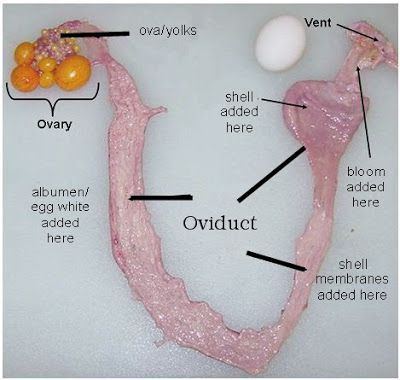
On the yolk’s surface, there are white spots, called blastodisc, which contain the female cell. When the yolk gets released from the ovary, it gets into the infundibulum, an organ that engulfs yolks. This is also where the whitish (albumen) gets manufactured.
Once there, a sperm will penetrate the blastodisc, initiating the fertilization process. Immediately after fertilization, blastodisc develops into an embryo, which grows until the egg is laid.
However, an egg doesn’t have to be fertilized to be laid. If it’s not fertilized in the infundibulum, it moves to the magnum, where the albumen forms fully.
Later it goes to the isthmus, where the inner and outer membranes form, after which it gets into the uterus or shell gland. Here the shells form before its laid.
Rooster
The roosters` reproductive organs are hard to identify. Unlike other animals whose reproductive organs are outside, roosters` are inside the body.
They have two testes located near the kidneys. These organs manufacture sperm, which passes via the vas deferens into the hen’s cloaca during mating.
How Do Chicken Eggs Get Fertilized?
Now, let’s shift our focus to the giant in the room: the egg fertilization process. Below, we have highlighted every step that leads to an egg getting fertilized.
Chicken Courtship and Mating Process
Like with many birds, courting in chickens is a dramatic affair that involves several behaviors and signals.
First off, the rooster drops one wing and dances around the hen. If the hen is compatible, she will dip her head and body to show her receptiveness to the rooster.
The male chicken will mount the hen, grabbing her neck, feathers, or comb with his beak to hold on to the hen’s back. The rooster will then position himself on the hen’s back (treading).
But mating only occurs when the rooster spread his tail feathers, allowing their cloacae could touch. At this point, the rooster releases sperm into the hen’s reproductive system through her cloaca.
Sperm Storage and Sperm Release
After mating, the sperm gets housed in the hen’s sperm storage tubules (SSTs) found in the oviduct. That’s to enable the hens to fertilize one egg at a time as ovulation happens.
After ovulation, the hen releases a single sperm which penetrates the ovum and fertilizes the ovum. The sperms take 15 weeks in the oviduct before they lose their ability to fertilize. That means even without mating, the hen can still fertilize eggs for a long time.
Fertilization of the Egg
When the sperm is released from the oviduct to the ovum, it penetrates the yolk into the blastodisc.
The two-combine causes rapid cell divisions or the formation of the blastoderm. These divisions, in turn, give rise to several cell types and set the stage for embryo development.
Egg-Laying
After ovulation, an ovum takes 15 minutes in the infundibulum and then it proceeds to the magnum where the albumen (egg white) forms on top of the yolk.
Later, it gets into the isthmus to form protective membranes, which are the outer and inner shell membranes.
Then it goes to the uterus or shell gland, where the shell is formed before the egg is laid.
Chicken Embryo Development and Hatching
When the eggs are laid, the embryo can’t grow and hatch without proper maintenance. That`s because the eggs alone can’t provide the necessary warmth and protection for an embryo to grow.
To enable the embryo to develop properly, the hen broods the eggs for 21 days.
During this time, the hen will display several behaviors aimed at protecting her clutch. These include:
- Sitting on her eggs and refusing to leave, unless to eat or drink (broody hens usually eat less food and water)
- Spreading wing and producing unique clucking sounds
- Pale combs and wattles
- Picking her belly and chest feathers
- Easily agitated
That said, a chicken sits on its eggs for 20-21 days to give you newly hatched baby chicks.
Within these days, the hen provides the required humidity to the eggs by splashing water from its beak when turning the eggs. The humidity softens the membranes, making them easy for the chick to break through when hatching.
The hen also turns eggs during brooding to prevent the chicks from sticking to the shell, which may cause bleeding and even death when hatching.
How To Look After a Hen Who Is Incubating
Do you know chicken eggs can fail to hatch after 21 days?
These could happen for many reasons, but perhaps the most common one is the poor health of the mother hen.
If you want to avoid such situations, you should take egg-stra special care of your incubating hen to ensure it stays happy and healthy.
But how can you do this?
First, provide your hen a safe space to sit on her eggs, away from other chickens that can disturb her and damage the eggs. Such an environment reduces the stress of the incubation process.
Also, ensure the nest stays comfortable and offer sufficient room for the hen to turn around when turning her eggs. Here are a few materials that could make the nest more accommodating:
- Pine shavings
- Plastic bags
- Chopped hay
Change these beddings regularly to remove any poop and to keep the nest clean
Second, keep water and food closer to the hen, so she doesn’t have to take much time going far for food. This could spell disaster because the more time the hen spends away from her eggs, the higher the chances of embryo death.
The hen must turn the eggs regularly to ensure the developing chick receives the right amount of temperature and humidity.
Some hens even break and eat eggs instead of brooding. Therefore, ensure to debeak the hen to reduce the chances of breaking the eggs. This also prevents cannibalism.
Last, trim sharp spurs and talons to prevent them from breaking the eggs too.
How Hatching Happens
On the 21st day of brooding, the embryo will have grown into a chick, and the hatching begins.
At this stage, the chick will have absorbed the yolk, which it uses for food. It then cuts through the membranes and starts pipping the shell.
It breaks the shell and makes a hole, then it stretches itself using its feet and gets out of the shell.
At this time, don`t disturb the hen. Doing so can cause it to damage the chicks. Also, don’t try to help the hatching chicks, since you can injure and kill them.
It takes 12 to 24 hours for a chick to break through an egg. If you see the hatching is unsuccessful past the 24-hour mark, you might need to intervene.
A chick may fail to get out of its shell because it’s weak or poorly positioned. The same can also happen if the air cell is not located on the blunt egg of the egg.
How Can You Tell If an Egg Is Fertile or Not?
If you plan to increase your chicken numbers, you must learn to differentiate between fertile and unfertile eggs.
But how can you tell them apart when they look the same?
The simplest way is to examine the egg’s yolk after cracking it. If you see a large white spot (germinal spot or blastodisc) on the yolk, the egg is fertilized. If the spot is small or non-existent, you probably have an unfertilized egg.
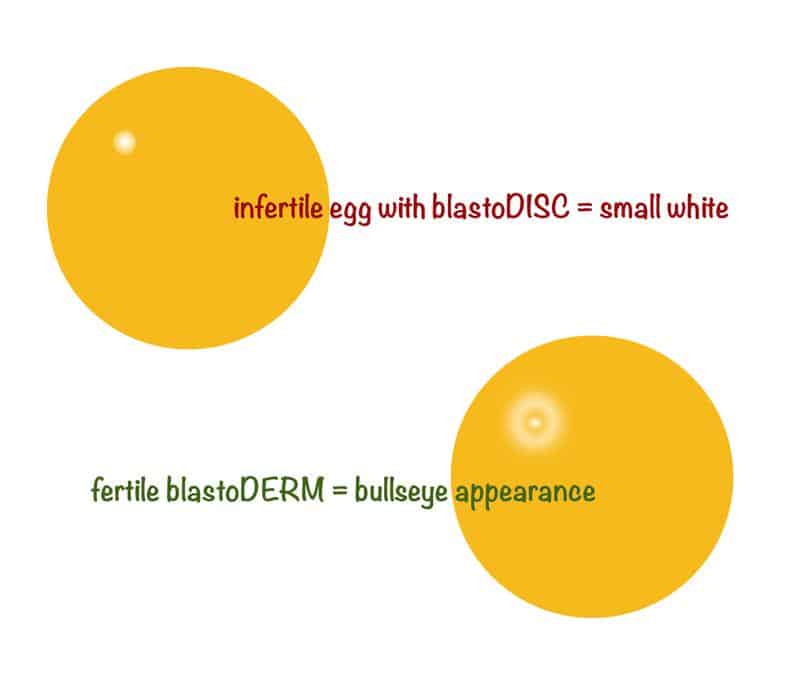
Sure! This method is easy, but it has one major flaw – you have to crack open the egg. But in this case, we want to hatch chicks. So, what is the next solution?
We move to the next method: the candling process.
You can use the candlelight to illuminate the inside of the eggs and search for structures like blood vessels that show the presence of a developing embryo.
In this image, the farmer uses a bright light source to illuminate the eggs instead of a candle.
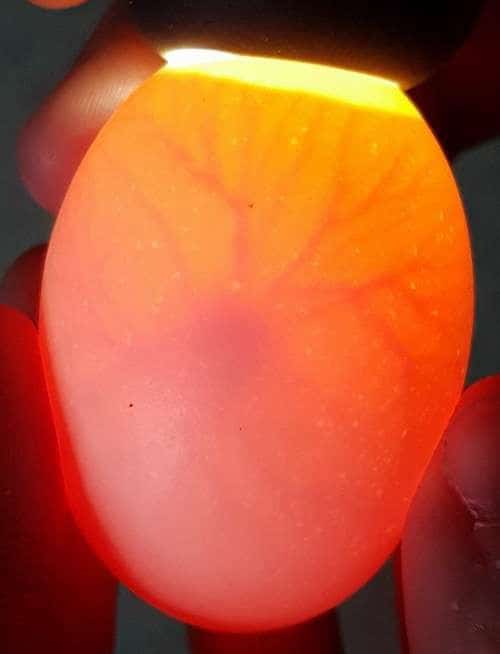
Simple, right? Well, not really!
This process requires patience, as you have to let your hen sit on the egg for at least 7 days or incubate the egg for the same number of days. You also need to go into a dark room to shine the light through the egg.
Challenges That Might Affect Egg Fertilization and Hatchability
Although egg fertilization is usually a smooth process, some challenges can arise.
Let’s start with infertility. It can stem from several factors, including genetic anomalies, disease, nutritional deficiencies, and hormonal imbalances. These could lead to the death of the embryo even before the egg is laid.
If the embryo overcomes these factors and the egg is laid, it’s exposed to another set of risks. For instance, usual temperature fluctuations can kill the developing embryo. Temperature changes also impact the success of the fertilization process.
Other factors that affect egg fertilization and hatchability include:
- Age of roosters and hens
- Insufficient nutrients and water in the egg
- Exposure to environmental conditions that don’t satisfy the needs of developing embryo
- Position of egg storage–eggs stored with their small end up having a higher chance of hatching.
What Does It Mean When There’s Blood on The Yolk?
The presence of blood in the yolk indicates that there is an embryo.
However, to determine whether the embryo is alive, blood vessels should be visible. If there’s a blood clot or a circular ring of blood, chances are the embryo is dead.
Also Read:
Bottom Line
From this article, we can establish that there are six stages of egg fertilization, namely:
- Courtship
- Mating
- Sperm storage
- Sperm release
- Egg fertilization
- Egg laying
We have also learned that broody hens display several signs, such as plucking chest and belly feathers and getting agitated easily.
But you can help them during their brooding and egg incubation stage by giving them food and water, moving the nest to a private area, and cleaning it regularly.
But keep in mind, a few challenges might affect egg fertilization and hatchability. These include environmental conditions, lethal genes, the age of the rooster and hen, and so on.
Armed with this information, you can approach egg fertilization with more understanding. You can also tell apart fertilized and unfertilized eggs, which is useful if you want to grow your chicken population.
We hope you’ve found this guide helpful. If so, please help us share it with your fellow poultry farmers, chicken enthusiasts, friends, and family.
